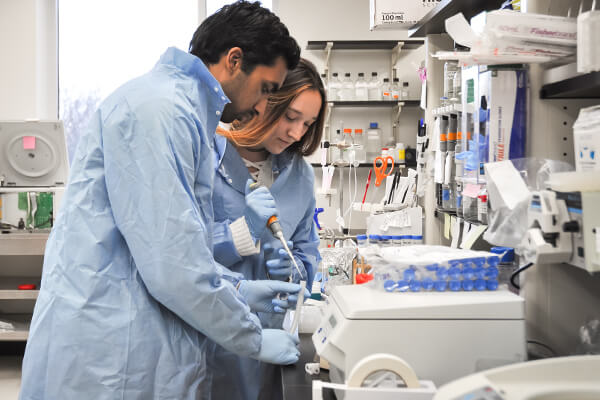- August 09, 2018
- By Irene Ying
Nasty bacteria are bad enough, but what if you’re stuck in a spacecraft with them on a lengthy mission?
A science experiment that returned to Earth last Friday from orbit could one day help astronauts beat germs in space. It was designed by two University of Maryland undergrads participating in the Student Spaceflight Experiments Program (SSEP).
Astronauts on the International Space Station (ISS) carried out their experiment to find out how well the T4 bacteriophage—a human-friendly virus that destroys harmful E. coli bacteria—is able to function in a weightless environment.
The students are still waiting to receive the experimental equipment back, but if data analysis shows the bacteriophage is unaffected by microgravity, it could provide a healthier way to keep spacecraft interiors clean.
“Sterility is extremely important in a closed environment like the ISS,” said Natalie Ivanina ’18, a biological sciences student. “Right now, astronauts use chemical cleaners, but those have harmful fumes.”
She and research partner Rushi Challa ‘19, a dual biological sciences and psychology major, prepared a mixture of dormant E. coli and T4 bacteriophage for the astronauts to activate in space. Once activated, the bacteriophage infected the bacteria. Two days later, the astronauts added a chemical to the mixture that killed the bacteria and viruses while preserving their genetic material.
Ivanina and Challa carried out a parallel experiment on Earth, working in the laboratory of bacteriophage expert Daniel Nelson, an associate professor in the Institute for Bioscience and Biotechnology Research with an appointment in veterinary medicine.
They also worked with Daniel Serrano, faculty specialist in the Institute for Research in Electronics and Applied Physics. He oversees Terps in Space, a group that has sent projects to the ISS for three years straight through SSEP.
Results from otherwise identical earthbound and orbital experiments will allow them to see how well bacteriophages perform in space. They could have broader uses as well, Ivanina says.
“Bacteriophage were studied ages ago as treatments for bacterial infections until antibiotics were discovered,” Ivanina said. “But antibiotic resistance is currently rising, so I think it could be worth studying them again for human health.”
SSEP is a program of the National Center for Earth and Space Science Education (NCESSE) in the U.S. and the Arthur C. Clarke Institute for Space Education internationally. It is enabled through a strategic partnership with DreamUp PBC and NanoRacks LLC, which are working with NASA under a Space Act Agreement as part of the utilization of the International Space Station as a National Laboratory.
